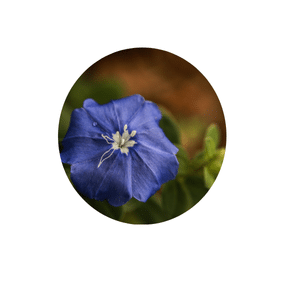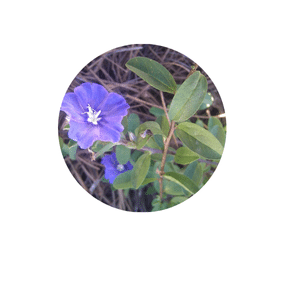Evolvulus glomeratus (ee-VOL-view-lus glaw-mer-AH-tuss)
Blue daze is a low growing plant that will provide you with large numbers of small bright blue flowers surrounded by a dense collection of tiny, gray-green leaves. If your color selections require blue you are in luck with this one! If you want a flowering ground cover or charm for your hanging basket you will like this one even more.
The plant is found in the Morning Glory Family (Convolvulaceae). Unlike the morning glory we all know and (maybe) love, this plant is non vining. The Genus part of it’s botanical name, Evolvulus, comes from the Latin word “evolvo,” meaning “to unroll” or “to untwist. The plant’s species name, glomeratus comes from the Latin “glomerare,” which means “to form into a ball or wind around”. So it forms a compact ball shape and does not twine around a support as morning glory does.
For a useful definition of how vining plants hold on, see Making an Entrance with Vines.

So will it close up like the morning glory? In the late afternoon or on very dark days you will see the flat, bright flowers close up. You will see it remain brighter, and longer than the morning glory vine.
Guide to Using Blue Daze Blooms
A tender perennial, Blue Daze is winter hardy to USDA Zones 9 to 11. In colder zones, it is grown as an annual in hanging baskets and containers or in the ground as a bedding plant or ground cover. Blue Daze tolerates a wide range of soils, including sandy soils and soils with poor nutrient levels. However, the soil must be well-drained, as Blue Daze plants that are too wet can quickly contract fungal diseases that will severely shorten their life span. Regular moisture and a balanced fertilizer will help get the plants established. The plants’ grey-green foliage serves as a backdrop for small but plentiful brilliant blue funnel-shaped flowers.
Consider these Uses:
- Edging for beds and borders.
- A flowering groundcover.
- Grow it over walls and down slopes.
- A spreading part of a container arrangement.
- Hanging Baskets and window boxes.
Here is a positive review of Blue Daze from Texas A & M.
Important Characteristics
Evolvulus glomeratus is a non-vining morning glory-like tender perennial with trailing stems that is native to Brazil. If planted in the ground as a bedding plant, it typically forms sprawling foliage mounds to 9-18” tall. It’s trailing stems will grow somewhat horizontally to downward when planted in baskets or containers. It has brilliant blue flowers over a carpet of fuzzy, oval-shaped green leaves. As an annual in containers, it is often hung over the edge of baskets; as a perennial ground cover, it spreads over stone walls or flower beds. It is not a hardy plant in temperate climates but you can use it freely for brilliant blues all warm season long. If planted in the ground, it will create a solid covering . It’s trailing stems tend to grow somewhat horizontally to downward when planted in baskets or containers. Flowers usually close up at night and on cloudy days.
Pests and Diseases
This is a sturdy and resistant plant with no known serious insect or disease problems. You can consider blue daze to be a low-maintenance addition to your garden.
Note that the minimum temperature tolerance for the Blue Daze plant is around 30°F (-1°C)
Guide to Places In The Garden To Use Blue Daze
Use blue daze with it’s spreading and trailing habit in any kind of container. Add them to hanging baskets, and window boxes. Plant in full sun, with regular water in dry periods and using a quality planting mix. They will prove easy to maintain and a bright addition to your displays.
A Pretty and Useful Groundcover

Blue daze will form a dense, low-growing mat of foliage in its blue-gray color. As such, it will suppress weeds and maintain the soil’s moisture. Its blue flowers are filled with nectar and your bonus will be butterflies and other pollinators.
Here are some tips for keeping your plants happy, especially during intense summer heat.

Blue Daze Plant Care Notes
This is a true full sun plant, happy to bloom steadily in 6-8 hours of sun. And even better, this is true in our steamy, south Florida summer days!
- Watering: Water this plant on a regular schedule while it is young and establishing its root system. While mature, consider it a drought-tolerant plant. Provide deep water during periods of extended dryness.
- Soil: Your one clear job with this plant is to make sure that the soil drains well! Once that is established, the plant is compliant in a wide range of soils. The preference is for a slightly acidic to neutral, pH 5
- Mulch: Apply a light layer of mulch to regulate the soil temperature and retain needed moisture.
- Pruning: Do you see leggy growth as your season goes on? If so, pruning will promote a compact shape and better blooming.
- Temperature: This plant is very heat tolerant, and here in South Florida we know heat! It will perform to 100 degrees Farenheit but will decline below 30 degrees.
- Regular Maintenance: No deadheading is required, the flower is very self-cleaning and the foliage is described in the literature as deer resistant. (Our resourceful marsh rabbits will eat them however. )
Blue Daze Companion Plants
Your blue daze plant will steadily produce its true blue flowers through the ‘dog days’ of late summer. Here are some lovely companion plant ideas to mix with blue daze.
Blue Fescue: this grass will provide a textural contrast, while keeping the blue-grey foliage color. Use it in zones 4-8.
- Bacopa: is a charming, small, trailing plant that provides delicate, small white flowers in high volume. (Do not let this one dry out!)
- Dianthus: ‘Pinks’ will offer pretty blooms in pink, scarlet and lavender and a bit of spicy scent.
- Lantana: will bring you bright colors, often several, on the same plant and attracts butterflies and hummingbirds too!
- Salvia: Not just blue flowers, look for pink, purple and red, too! Loves hot weather or cool, a good companion that appreciates the same treatment as blue daze.
- Marigolds: Bright yellow, orange shades to complement the blue. (These are true complimentary colors across the color wheel.) Also happy in heat.
- Petunia: For us this beautiful trailing plant is a ‘cool season’ addition. You in cooler climates will enjoy them all summer long. Big trumpet like flowers in a wide range of colors.
Like all good companion plants these above, appreciate the same growing conditions as the blue daze, although in our hot climate the petunias will not survive our humid summers.
Summary,
Blue Daze plants, or Evolvulus glomeratus, are charming low-growing perennials prized for their cascading blue flowers with subtle yellow centers and silvery-green foliage. Ideal for ground covers or container gardens, they thrive in full sun and well-draining, slightly acidic soil. Water deeply but moderately—allowing the topsoil to dry between applications—to keep them healthy. Occasional light pruning promotes a bushier habit and more prolific blooms, making Blue Daze a low-maintenance, drought-resistant addition to your garden.
